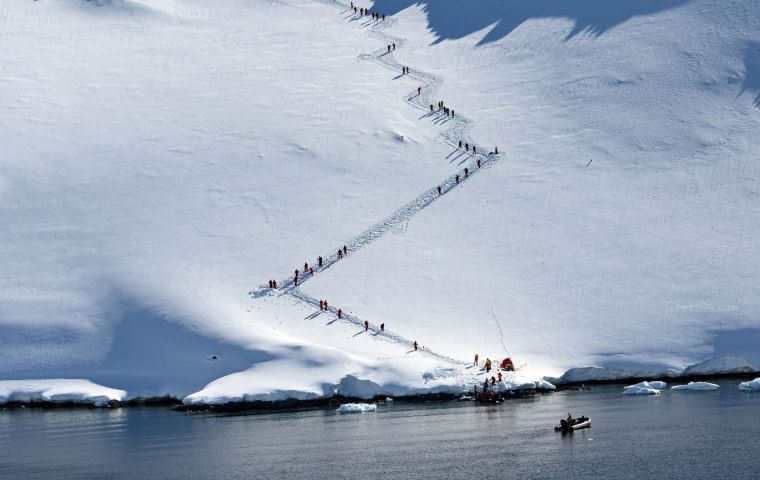MercoPress. South Atlantic News Agency
Why the pandemic’s pause on travel could be a defining moment for rethinking Antarctic tourism
 IAATO reported some 74,000 people visited Antarctica in the last spring/summer season (Nov 2019-March 2020), a 32% increase from the previous year.(Pic Getty Images)
IAATO reported some 74,000 people visited Antarctica in the last spring/summer season (Nov 2019-March 2020), a 32% increase from the previous year.(Pic Getty Images) By Eilís Quinn, Eye on the Arctic (*) – The current pause on international travel could be an important moment for the international community to rethink the future development of Antarctic tourism, says an expert on the region.
In a report published in Polar Perspectives, a new publication from the Wilson Center’s Polar Institute, Peter Carey says the pause in international travel because of COVID-19 is a valuable opportunity to consider tourism’s future impact on Antarctica, and what policies might help better manager visitors to the region.
“The current Antarctic tourism industry is very safe and environmentally friendly,” Carey, a Global Fellow at the Polar Institute, said in a phone interview from New Zealand. “My concern is that with the sheer numbers of visitors under the current system, we may not be able to maintain that.”
The International Association of Antarctica Tour Operators (IAATO), a non-profit alliance of tourism operators to the region, reported approximately 74,000 people visited Antarctica during the last spring/summer season (November 2019-March 2020 in the southern hemisphere), a 32 percent increase from the previous year.
Carey argues that in the past, spikes in tourism numbers have prompted regional tourism actors to adjust itineraries and ship schedules, but that the trend towards bigger and bigger visitor numbers suggests current means of navigating Antarctica’s popularity can’t go on forever.
“Increased visitor numbers have thus far been accommodated by self-imposed behavioural changes, such as lengthening the season, or pioneering new landing sites,” Carey says in his paper “Is it time for a paradigm shift in how Antarctic tourism is controlled?“.
“Additional small tweaks to the status quo may accommodate some further increases under the present regime, but eventually firmer controls will be needed if tourism is to avoid having more than a minor or transitory impact on the Antarctic environment or its intrinsic values.”
“With the pandemic forcing a pause in the upward trajectory of visitor numbers, is it time for a paradigm shift from visitor management to tourism regulation in Antarctica?,” he said.
Tourism at the South Pole
Tourism in Antarctica is essentially self-managed, and like other human activity on the continent, is guided by the agreements made by the international community under the Antarctic Treaty System (ATS), to which 54 countries are parties.
Strong shipping regulations are in place though the ATS and the International Maritime Organization (IMO) and the treaty parties have made tourism recommendations which include things like allowing a maximum of 100 visitors ashore at one time, but largely leave the IAATO to manage their own activities, Carey says.
Antarctic tourism operators must also apply for permits from their home country and undergo an environmental assessment of their activities. Currently, all such companies are from countries that are parties to the ATS.
And although the system works beautifully now, Carey said, it could be tested as new actors enter the industry, especially ones from countries that are not party to the ATS.
“The changing demographics of who’s coming to Antarctica may change the way things are conducted,” Carey said. “It will be important for the Antarctic Treaty nations to decide how to deal with different perspectives. Because currently, because of the way the system is set up, there’s no enforcement mechanisms.”
In his paper, Carey outlines four ideas that have been put forward for better controlling tourism in Antarctica that range from visitor caps or a quota system, to restricting tourism to specific zones, or requiring tourism operators to be sponsored by a treaty state, that would be responsible, and liable, for making sure the company respected all the relevant regulations.
Carey says each scenario has pros and cons, but that the current pause on international tourism due to COVID-19 is a valuable moment to start the conversation about the future of tourism to the continent.
“In the short term, if COVID-19 continues to gut tourism, not much will be at stake if things aren’t changed,” Carey said. “But if the pandemic gets under control and tourism takes off again, what’s at stake is we’ll have an area of the environment in Antarctica that will essentially be loved to death.
“We’ve been gifted with this time now where we can actually start looking that this, so let’s get talking.”
(*) Eilís Quinn is an award-winning journalist and manages Radio Canada International’s Eye on the Arctic news cooperation project. Eilís has reported from the Arctic regions of all eight circumpolar countries and has produced numerous documentary and multimedia series about climate change and the issues facing Indigenous peoples in the North.




Top Comments
Disclaimer & comment rulesCommenting for this story is now closed.
If you have a Facebook account, become a fan and comment on our Facebook Page!